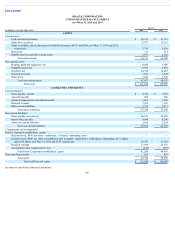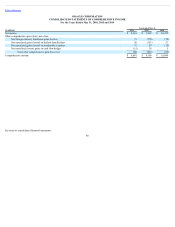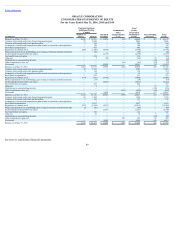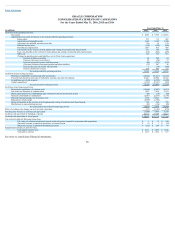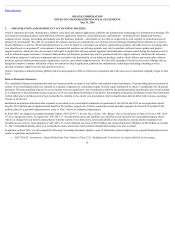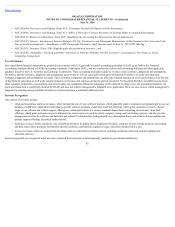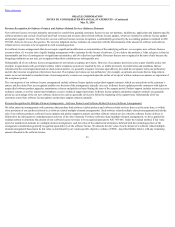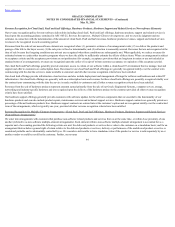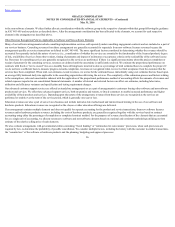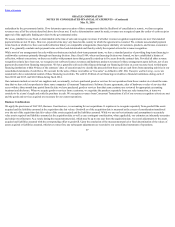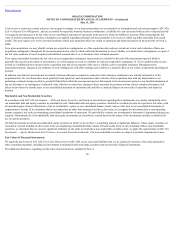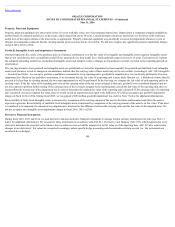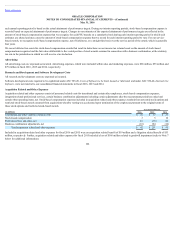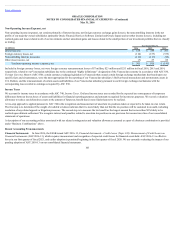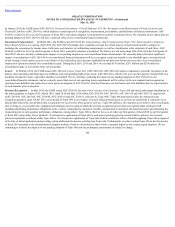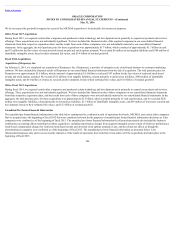Oracle 2015 Annual Report Download - page 98
Download and view the complete annual report
Please find page 98 of the 2015 Oracle annual report below. You can navigate through the pages in the report by either clicking on the pages listed below, or by using the keyword search tool below to find specific information within the annual report.
Table of Contents
ORACLE CORPORATION
NOTES TO CONSOLIDATED FINANCIAL STATEMENTS—(Continued)
May 31, 2016
to the non-software elements. We then further allocate consideration within the software group to the respective elements within that group following the guidance
in ASC 985-605 and our policies as described above. After the arrangement consideration has been allocated to the elements, we account for each respective
element in the arrangement as described above.
Other Revenue Recognition Policies Applicable to Software and Non-software Elements
Many of our software arrangements include consulting implementation services sold separately under consulting engagement contracts and are included as a part of
our services business. Consulting revenues from these arrangements are generally accounted for separately from new software licenses revenues because the
arrangements qualify as services transactions as defined in ASC 985-605. The more significant factors considered in determining whether the revenues should be
accounted for separately include the nature of services (i.e., consideration of whether the services are essential to the functionality of the licensed product), degree
of risk, availability of services from other vendors, timing of payments and impact of milestones or acceptance criteria on the realizability of the software license
fee. Revenues for consulting services are generally recognized as the services are performed. If there is a significant uncertainty about the project completion or
receipt of payment for the consulting services, revenues are deferred until the uncertainty is sufficiently resolved. We estimate the proportional performance on
contracts with fixed or “not to exceed” fees on a monthly basis utilizing hours incurred to date as a percentage of total estimated hours to complete the project. If
we do not have a sufficient basis to measure progress towards completion, revenues are recognized when we receive final acceptance from the customer that the
services have been completed. When total cost estimates exceed revenues, we accrue for the estimated losses immediately using cost estimates that are based upon
an average fully burdened daily rate applicable to the consulting organization delivering the services. The complexity of the estimation process and factors relating
to the assumptions, risks and uncertainties inherent with the application of the proportional performance method of accounting affects the amounts of revenues and
related expenses reported in our consolidated financial statements. A number of internal and external factors can affect our estimates, including labor rates,
utilization and efficiency variances and specification and testing requirement changes.
Our advanced customer support services are offered as standalone arrangements or as a part of arrangements to customers buying other software and non-software
products and services. We offer these advanced support services, both on-premise and remote, to Oracle customers to enable increased performance and higher
availability of their products and services. Depending upon the nature of the arrangement, revenues from these services are recognized as the services are
performed or ratably over the term of the service period, which is generally one year or less.
Education revenues are also a part of our services business and include instructor-led, media-based and internet-based training in the use of our software and
hardware products. Education revenues are recognized as the classes or other education offerings are delivered.
If an arrangement contains multiple elements and does not qualify for separate accounting for the product and service transactions, then new software licenses
revenues and/or hardware products revenues, including the costs of hardware products, are generally recognized together with the services based on contract
accounting using either the percentage-of-completion or completed-contract method. For the purposes of revenue classification of the elements that are accounted
for as a single unit of accounting, we allocate revenues to software and non-software elements based on a rational and consistent methodology utilizing our best
estimate of the relative selling price of such elements.
We also evaluate arrangements with governmental entities containing “fiscal funding” or “termination for convenience” provisions, when such provisions are
required by law, to determine the probability of possible cancellation. We consider multiple factors, including the history with the customer in similar transactions,
the “essential use” of the software or hardware products and the planning, budgeting and approval processes
96


